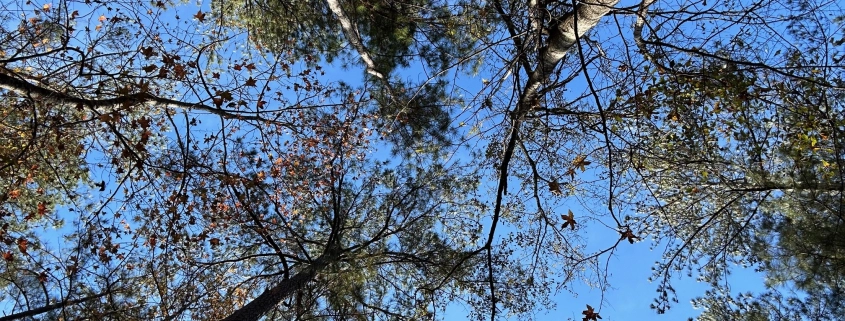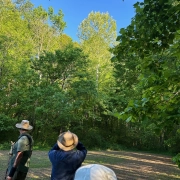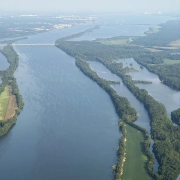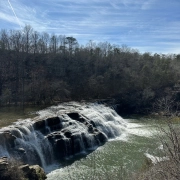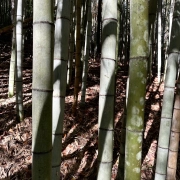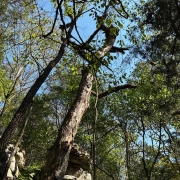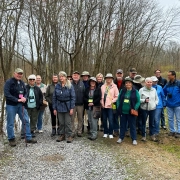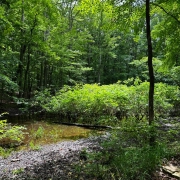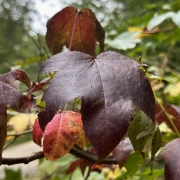Iron Bowl Visit to Auburn’s Kreher Preserve and Nature Center!
A Knee Surgery Preface
As I publish this photo essay, I am six weeks and one day since my January 23, 2024 total left knee replacement surgery. I stockpiled observations, reflections, and photographs from my woodland wanderings (like this November Iron Bowl trek) during the period leading up to my extended surgery recovery. My goal is to re-enter gentle forest trails by mid-March. Since surgery, I have been a tireless devotee of physical therapy. Okay, allow me a little humble honesty. Scratch the tireless. I’ve ended many post-surgery days exhausted from PT! Bear with me as I return to some semblance of my younger woods-worthiness!
Kreher Preserve and Nature Center
Chris Stuhlinger, a fellow retired forester and Auburn graduate, secured tickets for the 2023 Iron Bowl (11/25; Alabama vs. Auburn) and invited me to attend. I leaped at the chance. I had not attended a game at Jordan-Hare since the fall of 2000. Because the game did not start until 2:30, we visited Auburn’s Kreher Nature Center and Forest Ecology Preserve that morning. I offer observations, reflections, and photographs from our abbreviated one-hour visit.
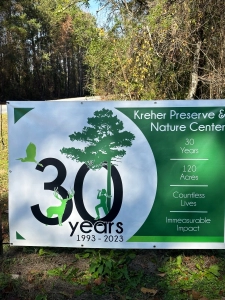
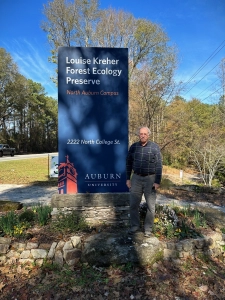
Just eight years from its inception when I departed Auburn University in 2001, the venerable Center and Preserve is now celebrating 30 years of immeasurable impacts on countless lives! I had no trouble visualizing eager learners of all ages across three decades. I did not expect many visitors on an Auburn Iron Bowl Saturday.
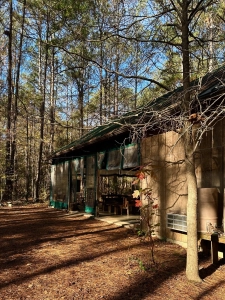
The primary education building sits comfortably within a loblolly and mixed hardwood forest that appears to be of old field origin. I hope to return to Kreher some day when not rushed by Iron Bowl engagements on campus. I’d like a full tour, complete with Center and Preserve chronology and land use history of the 120 acres. I had visited Kreher a time or two during my five years (1996-2001) at Auburn. If only my memories were more vivid. The forest was nearly a quarter of a century younger then. Here in the deep south, forests develop and grow rapidly. I would like to see photos from the Center’s establishment.
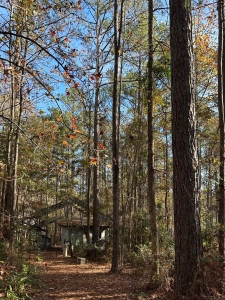
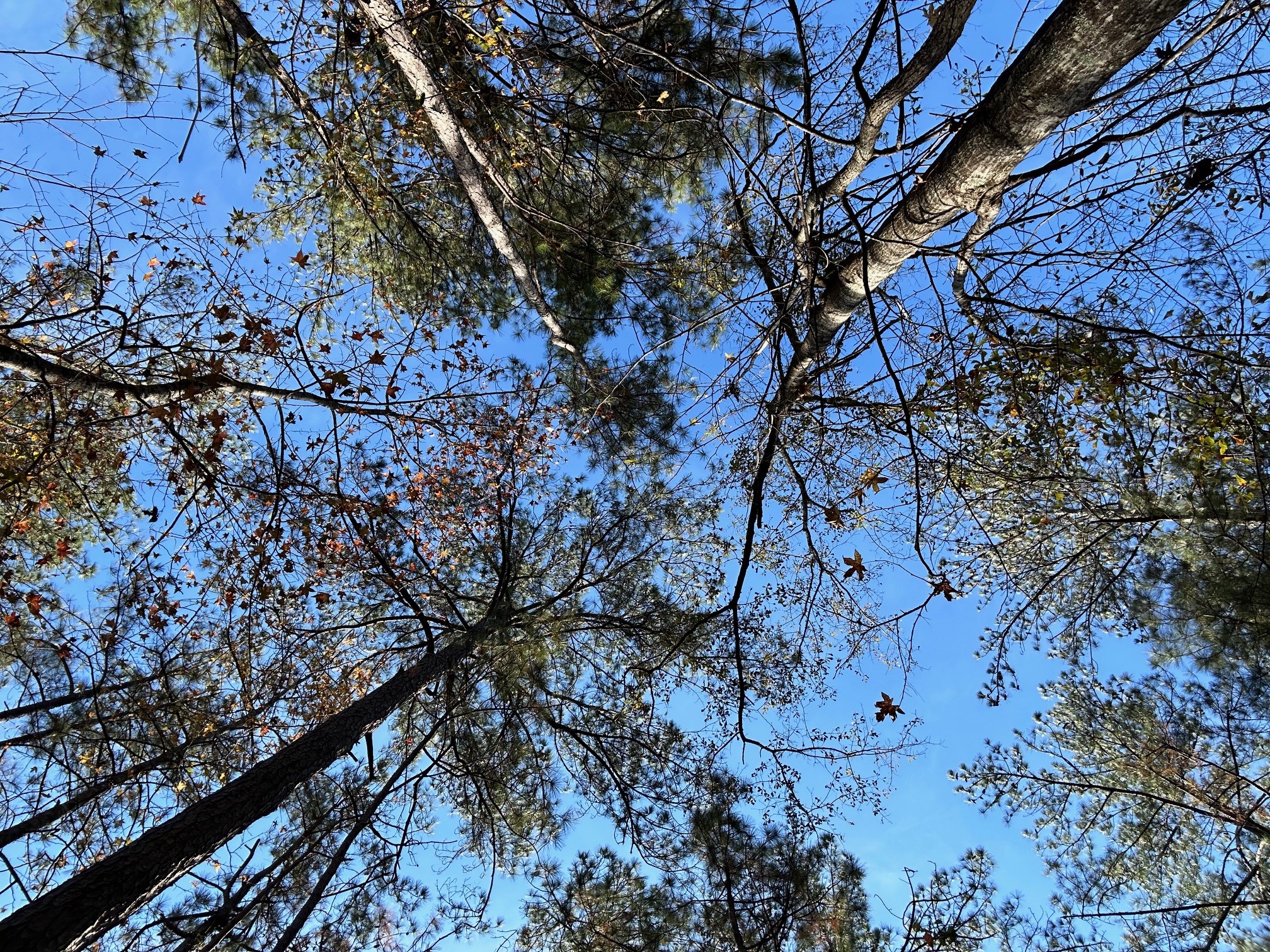
I am a tireless advocate for facilities such as this immediately launching a program to establish permanent photo plots throughout the property. The steps are simple:
- Identify 10-20 points in the vicinity of special landmarks, ecotypes, streams, etc.
- Sink a four-by-four treated wood post, with the four sides oriented to the cardinal directions
- Cap it with a numbered metal plate
- Decide the date to take the periodic photos. For example January 15 and July 15 every ten years.
During the fall 2023 Osher Lifelong Learning Institute at the University of Alabama in Huntsville semester, I took a course on Taking Better Nature Photographs. The instructor opened my eyes to a few tricks of the trade. Toying with one suggestion, I experimented with my iPhone, exploring my perspective preference with these two images. The photo at left derives straight from the camera, the lens peering into the forest horizontally. The view draws the more distant features (down the path and up into the canopy) toward the vanishing point; the trees appear to lean together. The image at right employs a finishing application that physically adjusts the image to eliminate the lean. The vanishing point, with the manipulation, in fact vanishes. I will continue to review my personal preference. For the moment, I am a lifelong resident of a world that operates with a vanishing point. I prefer the image below left. I’ll continue to experiment and share the results in these Great Blue Heron Posts.
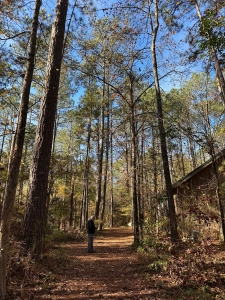
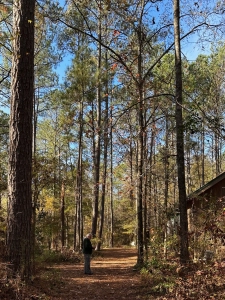
Education Amenities
The Center includes a wooden amphitheater, open to air and partial sunshine, ideally allowing participants to feel and see the pulse of woodland Nature. Effective Nature education is a contact sport. I’ve learned as much through outdoor osmosis as sterile indoor lecture. My most vivid learning endeavor involved muddy boots, chill breezes, and miles in a SUNY van slipping into New Hampshire’s White Mountains to study and experience watershed management at the US Forest Service’s Hubbard Brook Experimental Forest during spring break of my junior year. Young people visiting Kreher will not suffer Nature Deficit Disorder while on-site.
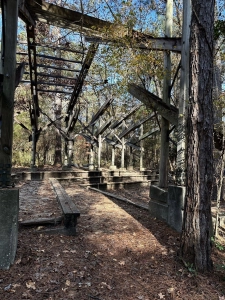
Some participants experience 24/7 immersion via overnight tent accommodations.
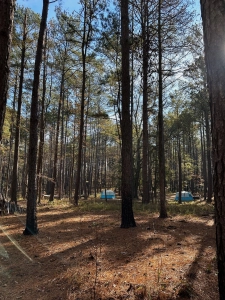
Again, I see a future Kreher visit, complete with a knowledgeable tour host and extended time for fully experiencing features like the KPNC Sensory Forest. The Kreher sign narrative strikes a chord with me:
Child development, school success, relational health, mental health, well-being, and resilience are all profoundly impacted by our body’s ability to process and integrate sensation.
Nature creates a natural, interactive sensory experience that can provide an equally therapeutic and stimulating engagement. The KPNC Sensory Forest provides stations along an accessible trail that harness these experiences and engage all seven senses. Take your time, explore the Sensory Forest, and engage YOUR senses!
Cheaha State Park also has a Sensory Trail (below right).

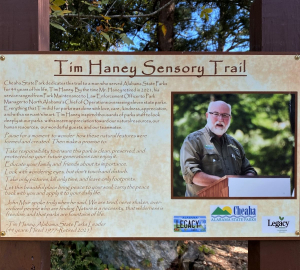
I like the seven senses images. I wonder, as I visit local trails and greenways, how many visitors are lost in their earbuds…sensory-deprived, experiencing only digitally what their device is pouring into their heads. For them, I fear, their senses image portfolio may include only a single symbol (below right).
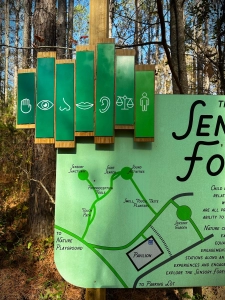
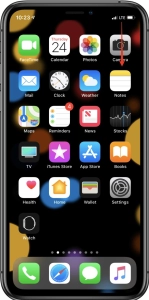
Soil: The Essence of Terrestrial Life
Soil is the fundamental substrate for nearly all terrestrial life. I loved my undergraduate courses in forest soils. I spent four of my dozen years with Union Camp Corporation leading the company’s tree nutrition and forest fertilization research program, an exceedingly soil-centered endeavor. I left the company to pursue my PhD, which evaluated soil-site relationships in the Allegheny Hardwood forests of NW Pennsylvania and SW New York. To this day, I consider myself an aging soil scientist. All that to explain why I like this 2015 Eagle Scout project at KPNC, the Soil Education Site.
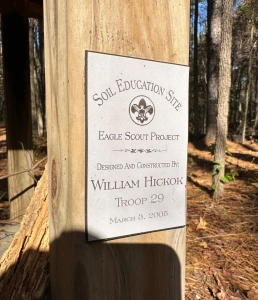
My compliments to William Hickok! He envisioned and created a soil profile display for the KPNC site, one open (left) and the other glass-encased (right).
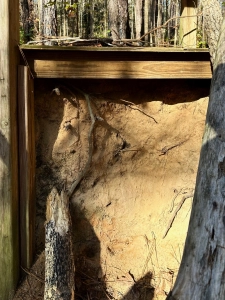
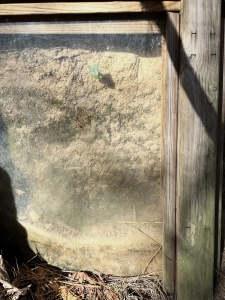
Young Mr. Hickok explained:
A soil profile is a vertical slice of soil showing the different layers, or soil horizons. Each horizon may be distinguished by its color, soil Texture (sand, silt, and clay content), mineral content, organic matter, and structure.
All soils in the Forestry Ecology Preserve are mapped as Pacolet sandy loam…
The soil profile that you see is a Pacolet sandy loam that was buried when a terrace was made here more than 60 years ago when cotton was grown on this site.
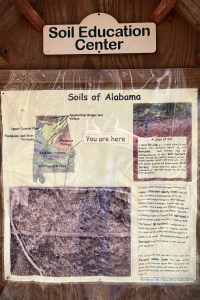
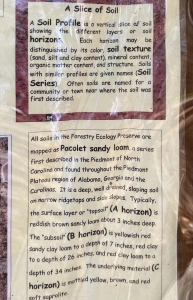
Eagle Scout Hickok thus confirmed y earlier observation: The primary education building sits comfortably within a loblolly and mixed hardwood forest that appears to be of old field origin.
Several older hardwood residuals stand along a natural drain dating back into the agricultural production period. Picture a cultivated field with young hardwoods sprouting along the drainage feature.
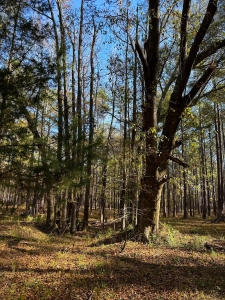
The trail signage professes a fairyland lilt, a youth-oriented theme, for the young and young at heart.
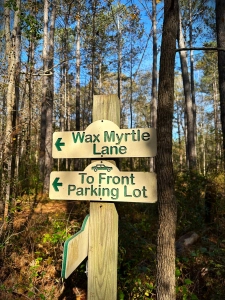
I embrace the notion of young at heart. My knees somehow have aged and declined far beyond the pace of the young man residing contentedly within the 72-year-old body! The young man who today achieves a case of misty eyes celebrating a grand woodland morning accented by the slanted rays of a late November dawn. Oh, how different would the scene have been 70 years ago with terraced fields and cotton stubble?
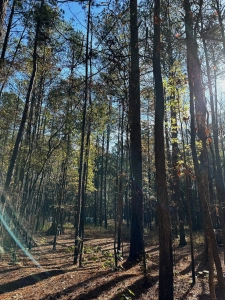
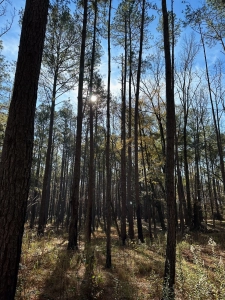
Southern Pine Beetles
Forestry studies require that we understand the insects and diseases acting within the forests we manage. Because I studied forestry in Upstate New York, I learned first hand of more northern insects and diseases. I didn’t encounter southern pine beetles until I hired on with Union Camp in 1973 in southeastern Virginia, where SPB infestations occurred periodically, necessitating monitoring, sanitation, and salvaging. I hope that KPNC staff have noticed the SPB infestation progressing on site. Pitch tubes offer the first evidence of infestation. When female adults enter a tree to lay eggs under the bark in the cambium, the tree reacts by exuding pitch to overwhelm the invading insects. However, when the beetles attack en masse, tree death proceeds rapidly. When large numbers of pitch tubes appear, the tree is likely already dead, its crown a reddish brown. So, usually, it is the dead crown that evidences infestation. Although when we stumbled upon the Kreher pitch tubes (left), the crowns were already dead (right).
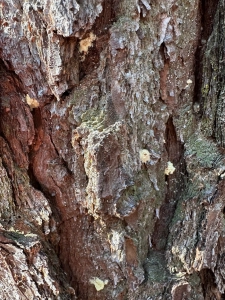
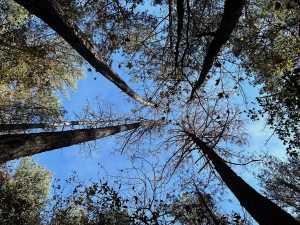
Another telltale sign is sawdust around the tree base, generated from larvae feeding under the bark.
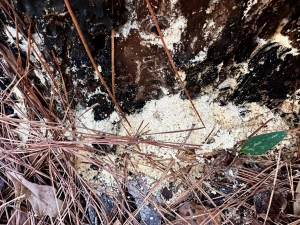
Fusiform rust (Cronartium) is a common southern pine disease. Tree improvement programs selected mother trees for seed orchards based upon fusiform resistance. Rust is not necessarily fatal, yet it reduces commercial value and can lead to breakage.
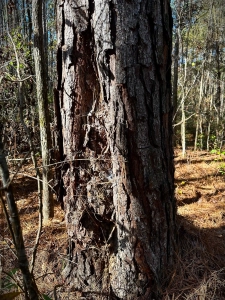
We found this severely contorted black cherry infected with black knot. This individual looks grotesque, a gruesome personality by appearance alone.
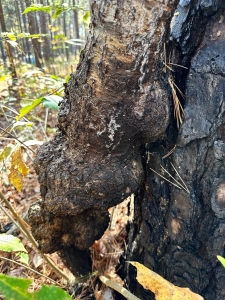
Insects and diseases are part of Nature’s great life and death continuum. As with many things in Nature, where we stand depends on where we sit. In the case of KPNC, each of these ecosystem features opens yet another educational moment.
Thoughts and Reflections
I offer these observations:
- The Kreher Nature Center and Forest Ecology Preserve is celebrating 30 years of immeasurable impacts on countless lives!
- Child development, school success, relational health, mental health, well-being, and resilience are all profoundly impacted by our body’s ability to process and integrate sensation.
- Environmental education is a contact sport!
- Insects and diseases are part of Nature’s great life and death continuum.
Inhale and absorb Nature’s elixir. May Nature Inspire, Inform, and Reward you!
Note: Unless otherwise noted, all blog post images are created & photographed by Stephen B. Jones. Please circulate images with photo credit: “©2024 Steve Jones, Great Blue Heron LLC. All Rights Reserved.”
Another Note: If you came to this post via a Facebook posting or by another route, please sign up now (no cost… no obligation) to receive my Blog Post email alerts: http://eepurl.com/cKLJdL
And Third: I am available for Nature-Inspired Speaking, Writing, and Consulting — contact me at steve.jones.0524@gmail.com
A reminder of my Personal and Professional Purpose, Passion, and Cause
If only more of us viewed our precious environment through the filters I employ. If only my mission and vision could be multiplied by untold orders of magnitude:
Mission: Employ writing and speaking to educate, inspire, and enable readers and listeners to understand, appreciate, and enjoy Nature… and accept and practice Earth Stewardship.
Vision:
- People of all ages will pay greater attention to and engage more regularly with Nature… and will accept and practice informed and responsible Earth Stewardship.
- They will see their relationship to our natural world with new eyes… and understand their Earth home more clearly.
Tagline/Motto: Steve (Great Blue Heron) encourages and seeks a better tomorrow through Nature-Inspired Living!
Steve’s Four Books
I wrote my books Nature Based Leadership (2016), Nature-Inspired Learning and Leading (2017), and Weaned Seals and Snowy Summits: Stories of Passion for Place and Everyday Nature (2019; co-authored with Dr. Jennifer Wilhoit) to encourage all citizens to recognize and appreciate that every lesson for living, learning, serving, and leading is either written indelibly in or is powerfully inspired by Nature.
I began writing books and Posts for several reasons:
- I love sauntering and exploring Nature
- I see images I want to (and do) capture with my trusty iPhone camera
- I enjoy explaining those images — an educator at heart
- I don’t play golf!
- I do love writing — it’s the hobby I never needed when my career consumed me
- Judy suggested my writing is in large measure my legacy to our two kids, our five grandkids, and all the unborn generations beyond
- And finally, perhaps my books and Blogs could reach beyond family and touch a few other lives… sow some seeds for the future

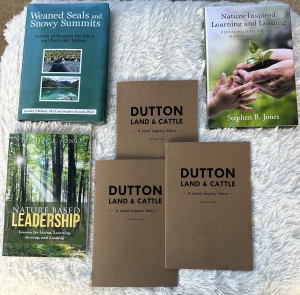
All three of my books (Nature Based Leadership; Nature-Inspired Learning and Leading; Weaned Seals and Snowy Summits) present compilations of personal experiences expressing my (and co-author Dr. Wilhoit for Weaned Seals and Snowy Summits) deep passion for Nature. All three books offer observations and reflections on my relationship with the natural world… and the broader implications for society. Order any from your local indie bookstore, or find them on IndieBound or other online sources such as Amazon and LifeRich.
I now have a fourth book, published by Dutton Land and Cattle Company, Dutton Land & Cattle: A Land Legacy Story. Available for purchase directly from me. Watch for details in a future Post.

